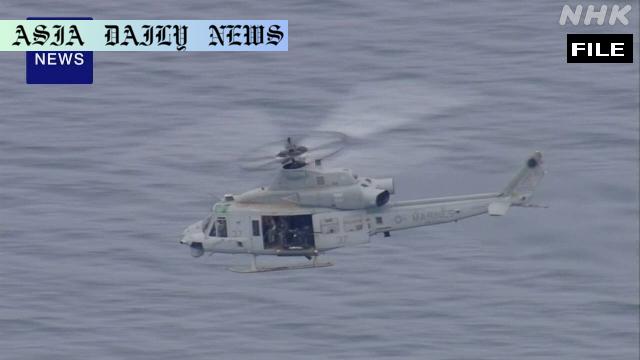Okinawa: US Forces report a bag with flammable devices fell from a Marine helicopter over the Motobu Peninsula. Public urged caution.
A US Marine helicopter dropped a bag containing flammable devices over Okinawa.
The incident occurred near the Motobu Peninsula, causing alarm in the area.
Authorities have warned residents not to handle the potentially dangerous bag.

An Unsettling Incident in Okinawa
A disconcerting event occurred on Tuesday in Okinawa Prefecture, Japan, as a US Marine helicopter deployed from Marine Corps Air Station Futenma dropped a bag containing flammable devices over the region. According to reports by the Okinawa Defense Bureau, the bag, which remains missing, fell during the flight over the Motobu Peninsula in northern Okinawa Prefecture around 4 p.m. This incident has raised several safety concerns and conversations about military operations in the area.
The bag reportedly weighs approximately 18 kilograms and is 90 centimeters long by 30 centimeters wide. It contained a set of signal flares, a type of pyrotechnic device typically used for signaling purposes. Acknowledging the hazardous potential of the flares, the bureau cautioned local residents to avoid handling the bag due to risks of accidental fire. It also urged anyone spotting the bag to report it to the authorities immediately.
Thankfully, no injuries or property damage have been reported as a result of this mishap, according to the Okinawa Defense Bureau. However, the incident has sparked debate about the safety protocols and overall precautionary measures observed during US military operations conducted in Okinawa. The Defense Bureau has promised a comprehensive investigation, urging better cooperation between the US and Japanese authorities to ensure such incidents are prevented in the future.
Implications for Military and Civil Collaboration
Okinawa hosts a significant number of US military bases and personnel, creating a complex relationship between the military and local communities. While the US military presence offers strategic significance in maintaining regional security, incidents like these reignite friction and mistrust within the populace. Historically, Okinawa’s residents have expressed concerns about the impact of military installations on their safety and environment, demanding stricter operational oversight and better communication mechanisms.
This event reinforces the importance of ensuring robust preventative measures within military training and operations to avoid mishaps that could endanger civilian lives. It also highlights the necessity for transparent and timely communication in the aftermath of such issues, as communities have a right to be informed about any risks to their safety. While the absence of injuries in this scenario is fortunate, the authorities’ response and commitment to rectifying the issue will set the tone for future collaboration and trust-building efforts.
The Broader Security Concerns in Okinawa
Beyond the immediate safety implications, this incident sheds light on broader geopolitical and security dynamics surrounding Okinawa. As tensions rise in the Asia-Pacific region, such mishaps raise questions about the readiness and professionalism of military personnel stationed in such strategic locations. The loss of sensitive, potentially hazardous materials during routine operations serves as a sobering reminder of the risks associated with military activities.
Balancing military necessities with the safety and welfare of the local populace requires nuanced policies. This incident may prompt reviews of current practices and suggest stricter guidelines for the handling and transportation of hazardous materials during training missions. The situation also underscores the importance of innovative technologies and monitoring systems to safeguard local communities from avoidable dangers.
Concluding Thoughts
While the Okinawa Defense Bureau has reassured the public of its proactive approach towards resolving the situation, this incident serves as a wake-up call regarding the little margin for error when it comes to safety in civilian areas. Authorities need to employ better coordination, communication, and vigilance in military operations to reinforce public trust and mitigate risks.
This event could serve as a valuable learning opportunity, provided it spurs actionable changes to military protocols and signifies a commitment to the well-being of local residents. In doing so, Okinawa could navigate its challenges toward a more harmonious coexistence between its people and the US military operations within the region.
Commentary
Understanding Local Tensions in Okinawa
The recent helicopter mishap in Okinawa once again emphasizes the delicate balance between military presence and local community concerns. With Okinawa hosting the majority of US military bases in Japan, residents are no strangers to contentious situations. However, incidents like this highlight the need for improved safety protocols to prevent risks to everyday life for local citizens.
As someone who follows geopolitical developments, I find this event concerning not only for the immediate impact on the public but also for what it reveals about operational safety gaps. For years, Okinawa’s residents have called for reduced military activity within the region due to disruptions and potential safety hazards. This event could fuel ongoing campaigns demanding policy changes or even a reconsideration of the US military’s footprint in Okinawa.
A Wake-Up Call for Military Operations
The reported absence of injuries in this case is indeed a relief, but it also serves as a fortunate warning for all involved. The oversight that allowed a bag containing pyrotechnics to fall during flight raises questions about the reliability of safety measures and equipment checks during operations. Moving forward, both US and Japanese authorities have the crucial task of re-evaluating operational protocols to ensure civilian safety. Such incidents cannot be brushed off as isolated events; rather, they must be treated as symptoms of deeper systemic vulnerabilities.
Finally, I believe this issue underscores the need for transparent communication and collaboration between military representatives and local leadership. Okinawa’s story is one of a region striving to assert its needs and safety amidst larger strategic considerations. Engaging the community and prioritizing their voices will ultimately help establish a balanced coexistence, reducing friction and building trust for the years ahead.


